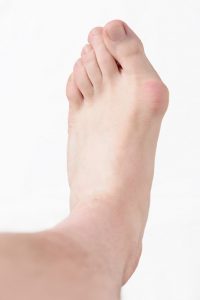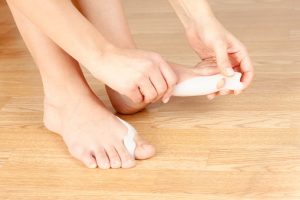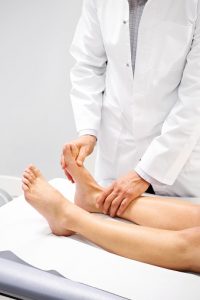Dr. Brian Nagy | March 29th, 2017
Posted In: Bunions, Foot Surgery
 Have you ever wondered what a bunion is, exactly? Or have you noticed a bump growing on your foot, where your big toe meets the rest of the foot? Bunions are fairly common foot deformities. It’s more common for women and older people to develop these deformities and suffer from bunion pain, but they can affect anyone.
Have you ever wondered what a bunion is, exactly? Or have you noticed a bump growing on your foot, where your big toe meets the rest of the foot? Bunions are fairly common foot deformities. It’s more common for women and older people to develop these deformities and suffer from bunion pain, but they can affect anyone.
If you have developed a bunion, you should have a podiatrist assess your foot. Without treatment, bunions won’t go away by themselves. Bunions are not only unattractive, but they can also cause pain and prevent you from normal day to day activities that involve walking or standing. You don’t need to suffer from bunion pain.
Your New Hampshire podiatrist should offer a thorough consultation and discuss a variety of treatment options with you, providing each patient with customized care to address your specific needs – your experience is unique and there is no one-size approach to care.
Bunions are bony lumps that develop on the side of the foot at the big toe joint with the metatarsal. Bunions develop slowly over time when the big toe joint moves out of alignment with the metatarsal bone in the foot and shifts to point outward while the phalanx bone of the toe tilts toward the rest of the toes. The bunion forms when the joint becomes inflamed. Since this joint is used in every step you take, bunions can result in quite a lot of pain.
Bunions are hereditary. If someone in your family suffers from bunions, your own risk of the painful formation developing is increased. Wearing narrow, tight, or poorly fitting shoes can also contribute to painful bunions developing. One of the reasons that women are more likely to develop bunions is because they wear narrow pointed toe shoes that force the toes into an unnatural position. Some inflammatory conditions such as rheumatoid arthritis can also lead to the development of bunions.
The most obvious symptom of a bunion is the large red bump that develops on the side of your foot. You may also experience pain or tenderness, especially when walking or standing for prolonged periods of time. The bunion may become red or inflamed.
Bunions are also susceptible to pressure and friction caused by shoes with narrow toe boxes that rub on the swollen joint. Calluses often develop on the side of the big toe where the shoe rubs. You might also develop calluses or hardened skin on the bottom of your foot. The bunion may also cause stiffness and restricted motion in the foot and big toe. This may lead to difficulty when walking.
There are a variety of non-invasive treatments that might relieve your painful bunion. The first and most important thing you should do is change your shoes. Wearing properly fitting shoes with sufficient space in the toe box will reduce the pressure on your toes and the MTP joint. In some cases, once the pressure is relieved over time the inflammation will subside and the joint will move back into proper alignment.
You will be advised to treat the inflammation as well as reduce the pressure on the joint. You can apply ice to the bunion several times a day, for approximately 20 minutes at a time to reduce swelling. You can also take nonsteroidal anti-inflammatory medications like ibuprofen or naproxen, which should help to reduce swelling and pain. If your bunion is caused by arthritis, you may be prescribed a different anti-inflammatory.
 Padding
PaddingYou may also find that wearing a protective bunion-shield to cushion the painful bump might help to relieve pain. You will still need to wear shoes that fit correctly and may want to test the bunion-shield pad as it may result in even more pressure on the joint if there isn’t sufficient space in your shoe for your foot including the swollen bunion and the padding.
Special orthotic devices may also help to realign the joint. You may wear either custom-made or over the counter shoe inserts. Toe spacers may also be suggested to keep your toes in the correct alignment. You might also consider wearing special splints at night that keep your big toe in a straighter position.
If you find that these less invasive treatments aren’t providing relief, it is possible that you may need bunion surgery to correct the alignment of your MTP joint. You will have a thorough physical exam and have x-rays of your foot taken before treatment, including surgery, if suggested.
While the exam and x-ray show the extent of your bunion, the main factors that indicate that surgery is necessary include your experience of pain while walking and standing that inhibits your normal daily activities and the ineffectiveness of less invasive treatments.
 What is bunion surgery?
What is bunion surgery?There are several surgical procedures that might be used to correct your bunion. Nagy Footcare specializes in minimally invasive surgeries to realign the MTP joint.
Bunion surgery is typically an outpatient procedure – patients will return home on the same day with recovery instructions to allow your foot to heal. The goals of any bunion surgery include realigning the joint, relieving pain, and correcting any deformities.
The specific technique used will depend on the severity of your bunion and any related deformity in the other bones or soft tissues of the foot. Often surgery involves the readjustment of the metatarsal bone beneath the big toe by making an incision into the ligaments surrounding the joint.
At Nagy Footcare, we specialize in minimally invasive bunionectomies. During this outpatient procedure, the doctor makes a small incision near the big toe joint and if necessary, removes any excess bone, then realigns the joint. This procedure is very effective at correcting alignment and relieving pain.
Your New Hampshire podiatrist will discuss the surgery with you and answer any questions you might have about the procedure. Also, remember that what works for you may or may not work for your friends or family members who have had bunions, as everyone’s experience is different. Don’t let another person’s story frighten you off of having the most effective treatment to address your pain.
At Nagy Footcare, our best day is when you wake up with no foot pain. We provide highly individualized treatment and care to make sure that you are fit and able to lead an active life, free from bunion pain. Painful bunions are easily treated, allowing you to get back to the activities you have always enjoyed. If you’re suffering from a painful bunion or even think that you might be developing a bunion, make an appointment with Nagy Footcare for assessment and treatment.
« What is an Ingrown Toenail and How to Prevent It | Discover Solutions and Treatments for Different Types of Foot Pain »